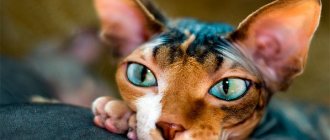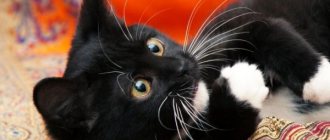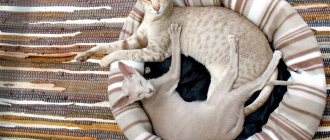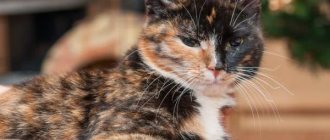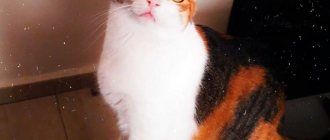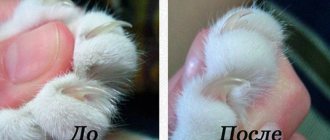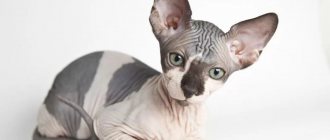Origin story
The homeland of these beauties with slanted eyes and unusually set ears is by no means the island of Java, as it would be logical to assume. In the late 70s of the last century, two American women, Anna Sandner and Maureen Davis, decided on an interesting experiment to breed a breed of cats that looked similar to Orientals, but had a wider range of colors and long hair.
The Siamese, Balinese and Shorthair Oriental genes used in breeding produced a stunning result: a long-haired cat, flexible and graceful like an Oriental Guria, and playful like a child.
The official registration of the new breed occurred in 1979. It was given the name in honor of the island of Java - a subtle hint at the Balinese (the island of Bali is adjacent to Java).
Breeding Javanese
On this path, a potential breeder will face many difficulties, which are associated primarily with the competent selection of individuals. Javanese breeders adhere to three “golden rules”:
- Do not breed only long-haired cats. With the constant crossing of only long-haired individuals, the kittens will be charming and appropriate for the breed, but uncompetitive from the point of view of an exhibition career, which leads to degeneration of the type.
- Regularly breed Javanese dogs with the best representatives of short-haired oriental breeds (Siamese, Orientals, color-point shorthairs). As a result of such matings, Vars are born - cats of an improved type, carriers of the long hair gene (SIA var, OSH var - Siamese Var, Oriental Shorthair Var - this is how they are designated in the pedigree, depending on the ancestor). Subsequently, these cats are crossed either with each other or with Balinese. As a result, the breed replenishes the gene pool and becomes better.
- Remember to preserve beautiful and high-quality “Balinese” wool. Short-haired Siamese and Orientals can have a bad influence on the quality of Javanese wool, so you need to choose short-haired Oriental cats not with ultra-short hair, but with longer hair. Only Javanese and Balinese dogs with the best coat type are selected as partners for them. This is the only way to preserve the distinctive character of the breed.
Removing javanese poses some difficulties
A few other rules:
- you cannot cross two carriers of blue eyes - the offspring will be born dead;
- It is forbidden to cross color-points with non-color-points. To improve non-color-point Javanese, Oriental Shorthair cats of various colors are used;
- cannot be used in breeding individuals with strabismus or carriers of any genetic diseases (corresponding tests to identify “bad” genes are carried out in a veterinary clinic).
When choosing individuals for breeding, it is also worth remembering the various intra-breed types:
- American and European Javanese are standard representatives of the breed;
- English Javanese are more powerful than standard ones. Their coat is much thicker (although the GCCF, the English felinological organization, prescribes the same as the CFA), they are less graceful than their American counterparts. The English type is not found outside the UK. They, like the “Americans,” were formed without the participation of foreign animals, in isolation, which led to such differences.
The Balinese are the progenitors of the American Javanese type.
Russian Javanese are closer to the European type. But their formation within the country was not in vain for them, and now Russian cats often have some disadvantages:
- light frame;
- flat forehead combined with too wide cheekbones;
- the appearance of semi-down and undercoat;
- incorrect size, shape and position of the ears.
You can try to improve the type of Russian Javanese with individuals from Europe and America. But it is much more effective to use Russian Siamese and Orientals, the type of which is close to ideal.
Cats cannot be bred before 1.5 years of age.
Colored Javaneses are not bred with color points.
Some tips for choosing manufacturers:
- remember about blood type compatibility: females of group A mate with males A and B, females of group B with males of group B, males A with females A, males B with females A and B;
- The class of the cat should be show or breed, but it is recommended to take only show cats;
- cats must be absolutely healthy and without genetic defects;
- It is necessary to prepare a package of documents: a pedigree or birth certificate with permission to participate in breeding work, a veterinary passport, if any - exhibition awards, as well as a purchase and sale agreement with the clause that the breeder gives the cat for breeding.
The future Javanese breeder will need:
- Get an education (felinological, veterinary, cat genetics courses).
- Open a nursery. This can only be done by obtaining a diploma of education as a felinologist (by completing a full-time or correspondence course). To open one, you need to contact the club of the breed you are interested in or the representative office of the organization in which it is recognized.
- Buy manufacturers. These can be Balinese, Javanese and Siamese, as well as Javanese and Orientals, depending on what color cats you want to breed: color point or colored.
- Participate with cats in exhibitions to obtain breeding assessments before mating. The cat will need to complete the title, and the cat will need to receive at least two ratings of at least “Very Good.”
- Get a referral for mating from the club where the nursery is registered. To do this, you need to provide pedigrees, titles and divorce assessments of partners.
- Wait until the cat is in heat and isolate them with the cat in a safe room for 2–3 days.
- If the mating is successful, wait 62–69 days until the kittens are born.
- Activate the litter no later than 8 weeks after birth. This is done in the club where the nursery is registered. Upon activation, kittens will be given birth certificates and a breeding certificate. You should come up with names for the kids in advance - they should start with the same letter. Litters are named in alphabetical order in Cyrillic or Latin (the first litter is A, the second, B or C, the third is B or C, etc.). The name of the club is the prefix or “surname” of the kitten.
Description of the breed
The Javan cat appears thin and fragile, although in fact it is a strong animal with muscles of steel, weighing up to 5 kilograms. A long slender body, high limbs with small graceful oval-shaped paws, a flexible tail that can bend in the most bizarre way are the characteristic features of this breed.
The Javanese's head, especially its elongated muzzle, resembles one of the wild relatives of our pets - a puma or a jaguar. Developed cheekbones, a sharp chin and a wide nose without a pronounced bridge of the nose especially contribute to this impression.
The ears of the Javanese are large, tapering upward, set wide apart, sloping to the sides.
The eyes are expressive, slanted, most often emerald green or golden green in color. Animals with white fur may have blue or light blue fur.
The long tail resembles a beautifully feathered feather, wide at the base and smoothly tapering at the tip.
The Javanese's coat is thin, smooth as silk, and completely devoid of undercoat. The belly and tail are more furry than other parts of the body, and the hair on them is longer.
Color
Corresponds to Persian variations.
The most common shades:
- tabby is a marble with stripes and spots, on the forehead between the eyes there is a characteristic mark in the form of the letter “M”. There is classic, mackerel and spotted tabby. The most famous combinations are blue, red, lilac and tortoiseshell tabby;
- plain - black, white, brown and silver variations.
The extremely rare lynx point color (color point with a touch of tabby) is also known.
Color point color
Several color options for Javanese wool
Pay attention to the tail, it is always fluffy
Typically a color point coat with tan, cream, light beige and cinnamon markings. Blue, tortie and tortoiseshell combinations are also possible.
Character
No less unique than the mysterious appearance is the character of the Javanese women. Most owners of these cats call donkey stubbornness the main feature of their pets. If a Javanese plans to sneak into a locked loggia and lie down in the middle of a flowerpot with violets, he will do it, even if it takes more than one week to implement the plan. If he wants to beg you for a tasty morsel of a dish that is completely unsuitable for him, you will no longer find suffering, pleadingly hungry eyes looking at you with silent reproach!
At the same time, Javanese are extremely playful. If you have a small apartment, it is better to choose a calmer cat instead of a Javanese. To fly up onto a cabinet, jump from it onto the lid of an aquarium, casually walk across the computer keyboard and immediately dive under the sofa - all this takes the oriental beauties seconds.
With other cats, especially those that are alive and as active as himself, the Javanese is on friendly terms. He can play happily with a small dog, but he will lightly tease a large one.
This cat seems like an ideal partner for children, but it is better not to let your child play with the Javanese. The animal may severely scratch or bite the baby if it hurts her.
Owner reviews
It is almost impossible to find reviews about the Javanese breed on Russian-language sites, because these animals are not very common in Slavic families. However, we found something. Olga from Moscow writes:
- Firstly, I am allergic, but I am very partial to cats and have always dreamed of such a pet. Because of this, I was recommended to get a Sphynx, but they scare me more than they attract me, so I studied the information and found a solution for myself - a Javanese. But they haven’t existed in our country yet. Before my birthday, my husband was sent on a business trip to the UK, from where he brought me the best gift - a small Javanese kitten. In practice, we have verified that it is truly hypoallergenic. By nature he is very independent and stately, but sometimes he can snuggle on my lap.
The owners note that the Javanese breed is hypoallergenic animals
If you are a lover of unusual cats, then an exotic breed is for you: an interesting appearance, reminiscent of a Persian cat, as well as a sea of love and affection towards the owners. Such a cat, unlike the Persian, will not require much care, but there will always be a soft and fluffy animal next to you that loves you.
Care
Despite their exotic appearance, Javanese require the same care as most of their furry relatives.
Twice a week, her silky coat is combed with a fine-toothed comb, after which the cat looks flawless.
Bathe javankas twice a year or as needed, but not too often, using high-quality pet shampoo. After this, the cat is wrapped in a soft, moisture-absorbing towel, the fur is dried with stroking movements and combed.
Javanese large ears require daily inspection and hygiene procedures. They are carefully wiped with a damp cotton pad, and at the slightest sign of discharge, immediately contact a veterinarian.
The eyes are washed every other day with warm water using cotton swabs.
Teeth are brushed two to three times a month.
Nails are regularly trimmed to 1-2 mm.
Javanese cat diseases
Javanese has a number of hereditary diseases that were inherited from her Siamese ancestors. The list of diseases characteristic of such a cat includes strabismus, which occurs quite often, problems with the gastrointestinal tract, asthma, and various heart diseases.
Observation by a veterinarian should be regular. If you suspect any health problem, you should immediately contact a veterinary clinic.
Conclusions about the breed
global $ads_google;
//data-ad-slot=”2475549904″ $ads_google = empty($ads_google) ? false : true; ?> if ($ads_google == false) {?> $ads_google = true; ?> } ?> about the Javanese cat with love; at the exhibition they attract every eye. We can summarize what kind of breed this is:
- External colorful beauty combined with a muscular body creates the image of an oriental cat;
- The nature of cats is suitable for people who prefer active pastime;
- The playfulness of a domestic cat will be appreciated by the owner's children;
- Pets are smart and capable of training;
- Health is not very good, kittens need care and attention;
- Caring for Javanese is not a problem;
- Such cats are very friendly and sociable;
- These are worthy defenders of any home from small rodents.
It is quite possible that a beauty with an oriental look will charm her owner at first sight, and will enter his house with love and devotion.
Nutrition
Active Javanese women, whose lives are in constant motion, require a special diet. It is best to give them premium or super premium food, rich in meat, vitamins and microelements.
If you prefer to feed your pets natural food, be sure to provide B vitamins.
The majority of a Javanese's diet should be lean meat: chicken, turkey, beef or veal.
Teach your cat to eat cottage cheese and kefir, which are indispensable for teeth and bones, and also contribute to better digestion of meat food.
A bowl of javanese must contain a variety of vegetables: boiled pumpkin, zucchini and carrots, fresh cucumber.
Walking and exercise
Our pets are distinguished from their Persian ancestors by their activity, mobility, playfulness and ease of movement, while the given criteria do not lose their relevance with the age of the animal.
We suggest you read: What to name a gray British female cat? Popular and interesting nicknames for British breed cats
Street walks are not at all necessary for them, but from time to time you can take your plush pet out into the yard on the grass. Don't forget the harness! Take your favorite treat for a walk so that the cat associates this process with something not only unusual, surprising and maybe even a little scary, but also very pleasant.
Cat and your apartment
Exotic kittens need warmth and comfort, so the animal should have its own small corner, a cat’s “house”.
You also need to pay attention to basic safety: put screens on the windows - this will help ventilate the rooms without risk to the animal, because due to the special structure of exotic cats, a fall often ends in death for them.
We hope that the exotic cat will become a true member of the family, bring warmth and comfort to your home, and live a long and happy life with you!
How to choose a kitten
It is best to look for kittens of an exotic breed in specialized nurseries, although you can often find a purebred kitten with or without documents in simple advertisements. When choosing a future pet, pay attention to the activity of the kittens: if a kitten sits on the side while its brothers run and play, it means that something is wrong with it.
Distinctive features of exotic kittens:
- average size - at the withers no more than 20 cm;
- stocky build;
- short and thick legs;
When choosing kittens, you need to look not only at the breed characteristics, but also at the activity of the animals - the head is large;
- short hair;
- the muzzle is very flattened.
It is best to buy a three-month-old kitten: at this age he can already do everything on his own, plus most of the vaccinations should already be done. If the kitten has documents, then it must have a certificate with it, which includes the name, gender, date of birth, and breed. You can then change it to a pedigree if you plan to take your cat to shows and engage in breeding. In any case, the kitten must have a veterinary passport, which contains notes on vaccination and treatment against helminths.
Before finding a new family member, you need to choose a nursery and “communicate” with all the kittens personally. An experienced breeder will always tell you which baby is right for your family, but you should, of course, rely on your own heart.
Don’t forget to ask the breeder to provide a veterinary passport with vaccination records and a pedigree.
Pay attention to the baby himself: a healthy baby will frolic and play with his brothers and sisters, he will not be afraid of people or show aggression. Don’t be shy to inspect the eyes and ears – they should be clean.




